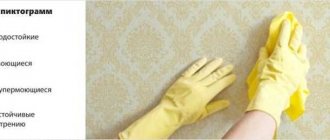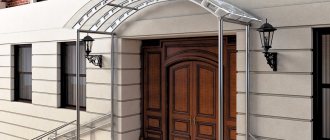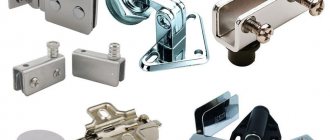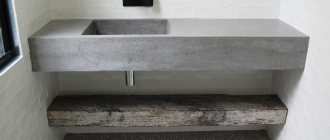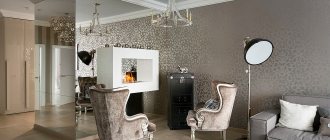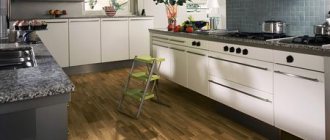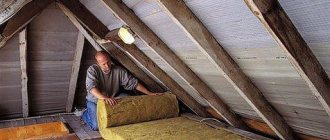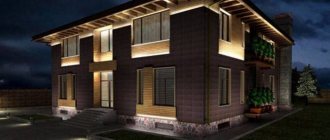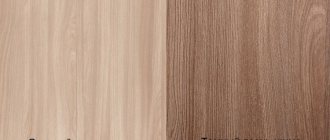A table is an important detail in the interior of an apartment or house. Such a purchase is made with the expectation of more than one year, carefully selecting the surface of the furniture to match the color scheme of the room. To protect the covering from external influences, the table is usually covered with a tablecloth or colored oilcloth. Transparent film on the table is a new modern way to preserve an ideal surface.
Features and characteristics of transparent film for the table
“Liquid glass” is a durable film for table protection, made using modern technologies from polyvinyl chloride.
It gained its popularity due to its advantages:
- remains almost invisible, without covering the color and design;
- a transparent film on the table will protect it from exposure to ultraviolet rays, moisture and household chemicals;
- it is heat-resistant and does not deform from high temperatures.
- “liquid glass” is suitable not only for the kitchen, but also for the office. It will protect the work surface from scratches.
- You can attach photographs, phone numbers, and necessary documents under a transparent thick film.
Transparent film on the table: before and after pasting
PVC material from which soft glass is made:
- hypoallergenic;
- flame retardant;
- wear-resistant;
- withstands low temperatures, up to – 15 degrees.
The thickness of the silicone film for the table is only 2-3 mm, the service life is 5 years.
When folding and transporting, no creases or cracks form on the silicone film. An unpacked tablecloth easily takes on its original appearance.
Furniture and interior items
45 votes
+
Vote for!
—
Vote against!
If you are pretty tired of the old interior design, you should pay attention to glass tables, which make it possible to successfully update the interior of any room. At the same time, a home craftsman does not have to buy such a table, but can make it with his own hands. Self-production of such furniture is, of course, not an easy task, but it will still be cheaper than buying a ready-made glass table. Let's talk today about how to make a glass table at home.
Features of glass tables
Mostly glass tables with a monolithic top are popular today. However, there are often so-called transforming tables that provide the opportunity to increase the length of the tabletop. The most important difference between glass tables is the appearance of the tabletop. It can have a variety of sizes and shapes: square, round, rectangular and oval.
Tables are made of tinted, frosted or transparent glass. Frosted glass is often greenish in color due to it being a natural shade of the material. In the interior, the transparent design of the glass table looks weightless. This property of the material makes a glass table indispensable if it is necessary to visually lighten the space. An opaque table of the same size and any design will always look more bulky and massive.
A colored glass tabletop will definitely attract a lot of attention. It is also necessary to say that the color of the glass structure can emphasize the style. For example, a black glass table for the kitchen makes it possible to create a “glamorous” or “Gothic” interior. You will get a good contrast if you complement the black dining table top with white chairs.
The base and legs for glass tables are most often chrome-plated or wooden, less often - wicker, plastic or forged. In some cases, a glass table is framed, then the frame is made of the same material as the table itself. There are also tables with a shelf under the main tabletop, but they, however, also have their own characteristics.
Before purchasing, ask the seller for permission to sit at this table, so you can check whether it is comfortable for you to sit at it and whether your knees rest on the table. No rubbish should accumulate in the table shelf, that is, the space should be in perfect order. Otherwise, there is no point in buying a glass table. But when receiving guests, you can put sweets or fruits on the shelf.
Advantages and disadvantages of glass tables
Glass tables have a lot of advantages, here are the main ones:
- Stylish appearance. Glass tables in the interior of any room look amazing and make the most pleasant impression. Transparency, flicker, shine and reflection make glass furniture inimitable. Glass tables look especially harmonious in interiors designed in high-tech style.
- Practicality. Modern technologies make it possible to manufacture glass tables with the expectation that it will be practical, reliable, safe and extremely stable. In addition, such glass furniture cannot be broken into pieces, because the glass used to make the tabletop contains special films that hold the fragments and avoid injury.
- High durability. Tempered glass is resistant to high temperatures and humidity. Glass countertops are absolutely not exposed to aggressive chemicals. They are hygienic and easy to care for, do not absorb fatty or coloring substances, which is a significant advantage over ordinary kitchen tables.
However, some owners did not like glass tables due to the large number of stains and prints on them. Dirt and crumbs are clearly visible on glass tables, and the surface of the tabletops gets scratched quickly. When paired with dishes, a glass table creates a lot of noise. However, these problems are easily resolved, and these shortcomings are not a reason to refuse to buy a stylish glass table.
The problem with permanent fingerprints on the glass can be solved by choosing a table made of frosted glass in the tint you need. To prevent soap stains from remaining on the glass surface, it is enough to buy a special glass care liquid. The noise problem can be eliminated by using coasters.
However, we should remember one more significant drawback - the high price of a glass table. Glass tables are very stylish furniture: they combine effectively with chrome surfaces, forged metal and lacquered wood. Therefore, their cost is much higher than the price of ordinary kitchen tables.
Making a glass table with your own hands
Let's look at the technology for making a glass table at home.
Preparatory work
At the very beginning of the process of making a glass table, you need to determine where your future table will stand, whether it will serve as a coffee table in the living room, or be used in the kitchen for eating. After you have decided on its purpose, you need to draw a sketch of it in accordance with the interior of the room. Be sure to indicate on the drawing the location of the legs and the size of the tabletop.
To work, you will need the following tools: a roller or diamond glass cutter, a long metal ruler, a rubber mallet and pliers with rubber pads for breaking glass. You should also take care of the glass itself. It can be colored, tinted, transparent, textured and mirrored. When choosing a canvas, it is best to use tempered material; the thickness of the glass for the table should be 6 - 12 millimeters.
The glass must be clean, dry and at room temperature. To clean it from dust, you can use a baking soda solution and a rag. This is very important, because when working with dirty material, a split may occur not along the cut line, and the glass cutter itself will fail faster. Glass prepared for cutting must be placed on a glass cutting table, chipboard or a thick sheet of plywood. The entire surface of the material should fit tightly to the table.
You need to place a thin rod under the line where you will make the cut. The diameter of the rod should reach approximately 3 millimeters. Next, place a ruler on the glass so that it is located approximately 2-3 millimeters from the line of the intended cut. It must be remembered that the glass cutter must be pressed with a force of 2 kilograms; this can be checked in advance using ordinary scales.
Glass cutting technology
It is better to cut glass using a ruler; it is preferable to use a thin metal one. Qualified craftsmen are able to cut glass “by eye”; at the same time, they measure the required length with a tape measure, move the glass to the edge of the table, orient themselves along this edge of the table and pass it with a glass cutter. You can also mark the cutting line with a felt-tip pen, and then use a glass cutter to draw it along the glass without a ruler.
It would be great if you practice a little on scraps before using the workpiece. This work is not that difficult, but training will add confidence to you and increase your chance of cutting glass well the first time. Soak the glass cutter wheel in vegetable oil before starting to cut on the far side of the glass. You should try to draw the cutting line with a glass cutter at one time.
If cutting is done with a diamond glass cutter, an almost imperceptible colorless mark remains on the glass. The force of pressing depends directly on the sharpness of the edge. Glass can be broken by hand, but it is better to do this with special protective gloves. The glass should be positioned so that the cutting line coincides with the edge of the homemade glass cutting table. Press the glass sharply and it should break in a straight line.
Remains or very narrow edges are broken off with a glass cutter, grabbing it with a special slot that is present on the glass cutter, or with pliers, on which rubber pads must be put on in advance. In addition, you can place paper folded in several layers under the jaws of the pliers. If the glass is poorly cut, then to increase the depth of the cut, you need to tap it with a glass cutter hammer from the back side, or with another tool - for example, an open-end wrench.
When working with a roller glass cutter, you need to apply more pressure. The cutting begins from the far edge of the blade. If the cut does not come out with a sharp glass cutter, then you need to move the roller back and forth along one line, first dipping it in kerosene. If the cut does not work out on the first attempt, then it is necessary to repeat the manipulation on the reverse side.
In cases where it is necessary to cut glass with complex outlines or a curved shape, a stencil is first made. After this, place the stencil on the glass and carefully trace it with a glass cutter. A circular cut of glass is made in a similar way: first, a cut is made in a circle using a template or another method, and then, in the part in which the glass will break off, rays are made and broken off in parts.
When it is necessary to cut reinforced glass, first you need to draw a cut line along the smooth side of the sheet with a roller glass cutter. After this, using a hard, sharp tool, scratch the groove along the cut line all the way to the mesh. Next, the glass is turned over and then broken. The wire is then carefully bitten off or cut.
Processing the edges of the tabletop
After you have successfully cut glass for a table, there are usually nicks and protrusions left on it that must be removed to protect against cuts or injury. It is best to process the edges of the glass on special machines, but this can also be done at home, be sure to wear cotton gloves.
To do this, take an old file or emery block. If you will use a file, you should prepare a small container with turpentine or kerosene to wet the tool. Next, file along the edge of the glass. You should work very carefully, especially if you are processing thin glass. To create smooth edges, you need to move the file or beam evenly along the glass.
After this, it is necessary to grind and polish the edges of the tabletop. For this action you will need a grinder or drill. Glass is polished at low speed - about 1200-1700 rpm, slowly, as it is afraid of overheating. First, coarser sandpaper is placed on the grinding wheel and the edge of the profile you need is formed.
Next, you should put a medium-grain disc and repeat the previous operation, while it is useful to moisten the glass with a thin stream of water. The edges are then processed with a fine-grained disc. The last step in finishing table edges is polishing the edge. This is done using a special paste and a soft felt circle. Polishing is done with the same drill or grinder.
Attaching the legs to the table
Now you need to think about how to secure the glass to the table. To install the table legs, you need to make a hole in each created leg on top of the end part. Suction cups are attached to these holes using special strong glue for these purposes. Next, after the glue has dried, you need to mark on the tabletop with a felt-tip pen and ruler the places where the legs will be installed. It is recommended to degrease such areas with gasoline or acetone.
The glue used to attach mirrors is visible through the transparent glass surface and takes quite a long time to dry - which is unacceptable if there are no additional fasteners when making glass. It follows from this that it is necessary to use special, highest quality types of glue in the process of making a glass table.
Russian manufacturers produce fairly decent glue in two varieties: “glass-to-glass” and “glass-to-metal”. Just like other types of special compounds, this glue also has its own characteristics - it dries, polymerizing in ultraviolet rays, with a length of 300-400 nm. The time it takes for the adhesive to completely “dry” depends on the power of the lamp used. The initial gluing takes approximately thirty seconds.
Glue the legs to the glass tabletop one at a time and wait until they set. And only then irradiate until the adhesive composition is completely polymerized. Please note that tearing off the leg and redoing it will not work, so mark the attachment points carefully. Carefully measure the amount of glue; of course, you can remove excess glue with a sharp knife, but this work will not be enjoyable. So you have made a glass table with your own hands!
Tips for using a glass table
A glass table needs careful care. The table should be wiped with artificial suede or a soft microfiber cloth: these materials leave the least amount of streaks. You can also use special cleaning products for mirrors and glass, which are sold in household chemical stores. But still, if you have children in the house, we strongly recommend reducing the cleaning time using “chemicals”, since sooner or later you will put food on the table on which particles of the products used may remain.
Sometimes, due to the tricks of our kids or due to carelessness, scratches appear on the glass, spoiling the appearance of the product, but we want everything to be perfect. In this case, there is a simple solution - grinding with GOI paste. This paste must be crushed into very fine crumbs so that the mass is homogeneous.
Next, you need to take a regular cotton swab and dip it into the paste on all sides so that the cotton swab is completely covered with a layer of crushed substance. And after that, start polishing the scratch with the paste, without pressing too hard on the stick. The time period of one approach is 10-15 seconds, after which it is necessary to remove the paste from the glass, apply a new portion of crushed paste to a cotton swab and repeat this process again.
How many passes you need to make depends on your patience, the scratches themselves, and the type of glass the table is made of. But if the work is completed, your reward will be a glass surface that will be absolutely scratch-free. Also, in addition to GOI paste, there are many other polishing substances - “Polarit” and final polishes, which contain diamond particles. Many owners choose toothpaste for polishing.
In addition, you can use the following option. It does not consist of eliminating scratches, but of hiding them. To do this, it is customary to use regular colorless nail polish. It must be carefully applied to the scratch, without going beyond its edges, and allowed to dry thoroughly. If the scratch is quite deep, then the procedure must be repeated more than once.
Remember that each layer should be allowed to dry fairly well before applying a new layer. And to avoid scratches, stains and chips, it is recommended to place special napkins on the table, of which there are a great variety on sale today.
Thus, a glass table will look better in the kitchen than, for example, a wooden one. You can buy a table made of plastic, but still a glass one will be much more beautiful and elegant. Also, a glass table would be appropriate in the living room near the sofa. What is there! It can become the central element in your interior, especially if you made it yourself.
Advantages and disadvantages of the material
Advantages of liquid glass film for the table:
- Ease of removing contaminants that are removed from the surface without the use of cleaning agents and detergents.
- Easy to care for the product.
- Invisibility - a transparent thick film is invisible on the table and does not violate the integrity of the interior of the room;
- Durability - silicone material can serve as a coating for several years.
- No smell.
- Stability on the surface - the silicone tablecloth does not slip or move from the tabletop.
The tablecloth-film on the table also has minor drawbacks.
1) It is not resistant to direct fire. If cigarette ash or a burning match gets on the tablecloth, a stain will remain on it.
2) Silicone is damaged by a knife, so it is necessary to cut products on a special board.
3) If not laid correctly, bubbles will form under the tablecloth.
Silicone table pads
Types of soft glass tablecloths:
- The bulk of silicone pads are available in a colorless version.
- There are silicone tablecloths for tables with a pattern, which allows you to give the room a more original look. Any design is applied to the film on the inside, which guarantees a long service life. Most often, images of fruits, berries, flowers and intricate geometric shapes are used.
Transparent silicone pad with a pattern
- Buyers have the opportunity to purchase a matte film; it looks quite unusual on the countertop and does not interfere with the overall interior.
Matte silicone pad us tol Ikea
For the convenience of using thick film, you can attach special corner silicone pads to the corners of the table. They additionally prevent premature damage to furniture.
Corner pads will be useful for families with small children; they will prevent injuries from sharp corners.
Corner silicone table pad
How to choose the right one?
When choosing plexiglass for a table, you should pay attention to some points:
- The thickness will depend on the purpose for which the glass is purchased: if as a decorative decoration, then you can opt for a thin product; if the main emphasis is on the protective function, then preference should be given to a thicker model.
- If the length of the plexiglass is not enough to cover the entire tabletop, then you can combine several separate overlays.
- Rounded or sharp corners. If a product is purchased for a schoolchild’s desk, then it is better to give preference to a model with rounded corners in order to protect the child from injuries and damage.
- Glass on a table can not only decorate the tabletop, hide minor imperfections in the surface, but also become an indispensable and functional attribute in organizing the work process of both a schoolchild and an adult.
How to give a second life to a glass table? Watch the next video about this.
For which table surfaces is transparent film suitable?
Silicone film is suitable for almost any type of countertop, provided that it has a smooth surface.
Below are the most common use cases.
- Film for a glass table is the best option, as it will protect it from chips, cracks and scratches and will be almost invisible.
- A transparent film on a metal or wooden table is also a good solution. Its thick surface protects furniture from getting grease, dyes and getting wet.
- A thick transparent film is also suitable for a plastic table in a children's room. The transparent surface will protect the furniture from paint and plasticine while the child is studying.
- Covering a marble table with film is a bold decision, but thanks to it, excess moisture will not penetrate into the stone surface.
Features of computer desks with glass tops
A pleasant feature of any glass piece of furniture is its visual lightness and visual expansion of space.
A glass product has a number of advantages.
- The manufacturer offers a wide selection of models in design, size, and additional equipment.
- The material is impervious to moisture.
- Transparent surfaces are easy to care for, but, unfortunately, this needs to be done quite often.
- They can withstand loads of up to 100 kg.
However, glass models are not without their weaknesses.
- A slippery tabletop surface can make it difficult to use a computer mouse. The issue can be easily resolved with the help of a special mat.
- Many users experience discomfort during tactile contact due to the coldness of the working surface.
- The high cost of the product often forces one to choose computer desks made from more affordable materials.
- Hand stains and stains quickly appear on the surface of the table, and dust settles, so you have to clean it frequently.
- This design is difficult to adapt for storage due to its transparency; the tangle of wires also does not look very nice. However, if you choose a table in black or matte, the problem is removed.
- Glass is not able to dampen sound vibrations, which can cause irritation to others and the user himself. In this case, a rubberized mat will come to the rescue.
Structures consisting only of glass are quite rare. Typically the product includes: a frame made of metal or wood, a glass tabletop and shelves. There are also models with a cabinet made of chipboard.
How to lay film on a glass table
The overlay is laid on the surface without any particular difficulties, but it requires following a special algorithm:
- Before covering the table with film, it is wiped from dirt and dust so that the stains are absolutely invisible.
- Then the “soft glass” is spread on the surface and pressed against it with both hands.
- If bubbles have formed under the cover, the “liquid glass” should be carefully lifted, spray the surface with water from a spray bottle, and press again. This method of installation will allow air to escape along with water, and the magnetic film will be leveled on the table.
How to care for the product
“Liquid glass” requires simple care. It should be wiped with a damp microfiber cloth or soft cloth.
Fleecy fabric is not suitable for caring for the surface of the tablecloth; it will leave marks. It is not recommended to use powders and products containing alkali, chlorine and acid for cleaning. Their use will significantly reduce the life of the tablecloth.
To remove an old grease stain on an adhesive film on the table, you need to apply a small amount of dishwashing detergent to it and leave it for a few minutes. Then the surface is wiped with a soft cloth.
The most famous manufacturer of table film in the world is the Japanese company Meiwa . They provide clear, colored, matte overlays to the market. , both in large rolls and in standard tabletop sizes.
In terms of their positive qualities, glass table films from domestic manufacturers do not lag behind Japanese ones. Decosave and Modern companies produce both transparent overlays and tablecloths in various shades and patterns, which allows you to match them to any interior.
The best company in Belarus producing transparent thick film for the table is considered to be “Ofiston” . Their transparent tablecloths have gained popularity among customers, which indicates the high quality of the product.
Everyone has probably heard about the Swiss company Ikea. The quality of this company's products is evidenced by many positive reviews. The models of table films that are most quickly leaving the shelves of the Ikea store are the transparent “Preuss” and “Skrutt” .
The following companies are also successful in selling silicone tablecloths:
- Durable;
- Esselte;
- Leitz.
How much does soft glass cost?
The cost of silicone film for the table depends on the size. Below are approximate price categories:
- 70*60 cm = 1000 rubles
- 140*60 cm = 1500 rubles
- 140*80 cm = 1900 rubles
- 140*100 cm = 2200 rubles.
When purchasing a new table for your home, you can choose the most beautiful options. Don't be afraid to experiment with colors and materials, don't be afraid to buy glass furniture. The transparent overlay will extend its use for quite a long time.
What kind of glass are tabletops for computer desks made of?
Tabletops are made from a certain type of glass, which has been processed using a special technology: exposure to temperatures of more than 600°C. Its thickness ranges from 8 to 20 mm. The side edges are carefully polished and do not contain sharp areas. The texture of the edge is smooth or slightly rough. Tempered glass is highly durable and reliable. It is quite difficult to break it.
The weak point is in the end part. With a strong impact, a wave is formed that completely destroys the surface. As a result, fragments without sharp edges are formed.
Various types of glass are used in the production of tables.
- Transparent. A product made from it is almost invisible due to the absence of a shadow. Particularly pleasing is its ability to add light and volume to any room.
- Matte. This option is less demanding to maintain and creates an interesting velvet effect.
- With a pattern made by sandblasting. This treatment gives the model a sophisticated and expensive look.
- Tinted. Perfectly hides objects located on shelves and numerous wires.
- Colored. Such a table will become an accent of the decor and add mood. The white product is an ideal choice for Scandinavian or high-tech style. The black model will easily fit into the modern style. Bright shades (red, orange, blue) are suitable for a schoolchild or teenager's room.
- With photo printing. The image retains its original brightness and shades throughout its entire service life, giving the product a unique design.
